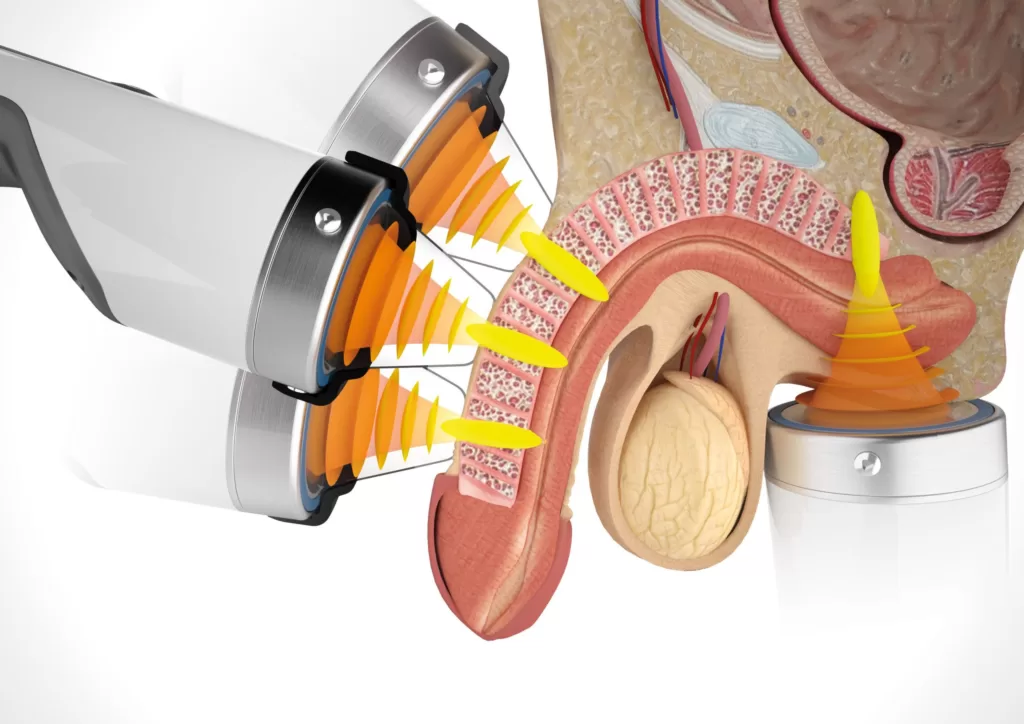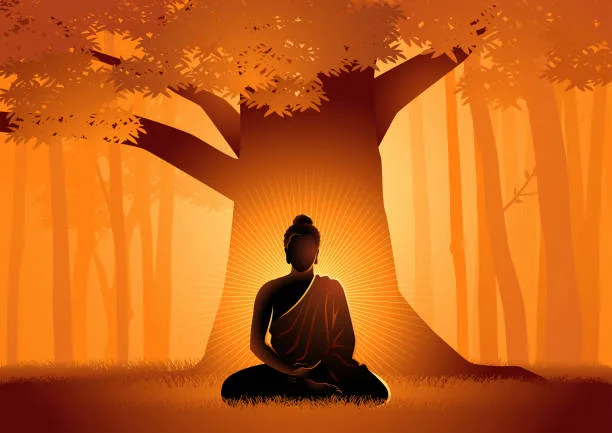When it comes to treating erectile dysfunction (ED), shockwave therapy is just one option among many. Even though the FDA hasn’t given its blessing to this pill-free treatment, the science behind it has been supported by a number of studies, such as Extracorporeal shockwave therapy at a low intensity.
Low-intensity extracorporeal shock wave therapy (LIESWT) may help neovascularization by releasing angiogenic growth factors and activating tissue repair functions. These include increased macrophage activity, changes in cellular apoptosis, more synthesis of cellular proteins, and activation, as well as more stem or progenitor cells being recruited and then differentiating.

Many clinical investigations have reported favorable findings in the use of LIESWT, including better erectile function, a good safety record, and short-term durability, and there is emerging evidence to support its usage, especially in vasculogenic erectile dysfunction. During the course of the trial, patients with moderate to mild erectile dysfunction reported stronger therapeutic efficacy from LIESWT than those with more serious erectile dysfunction or those with several medical comorbidities, and this effect appeared to endure for at least three months.
Whether or not one LIESWT machine is preferable to another is uncertain, despite the fact that current clinical trials reveal that the activation effects and therapeutic mechanisms are similar among machines despite physical variances and the treatment template. Determining the appropriate LIESWT therapy protocol requires identifying the most effective treatment design, shock wave energy mode, emission frequency, and total energy delivery.
Before LIESWT technology is established as the accepted standard of care in ED, more rigorous randomized controlled studies with more long-term follow-ups are necessary. Patients with vasculogenic ED, a condition resulting from a blood vessel malfunction that reduces blood supply to the penis, appear to benefit the most from shockwave therapy. It needs to be explored if the therapy is beneficial with additional reasons for erectile dysfunction.
What is shockwave therapy?
Shockwave therapy, which is mostly known as extracorporeal shockwave therapy (ESWT), is a non-invasive medical treatment that utilizes powerful-energy sound waves to stimulate the body’s natural healing processes. The therapy was initially developed to break down kidney stones, but over time, its applications have expanded to various musculoskeletal conditions. During a shockwave therapy session, a specialized device delivers controlled shockwaves to the targeted area of the body, such as tendons, ligaments, or muscles. These shockwaves create a mechanical pressure that triggers the release of biochemical substances, promoting tissue regeneration, improved blood circulation, and pain relief.
The therapeutic effects of shockwave therapy are attributed to its ability to stimulate cell growth and accelerate the healing process. The controlled shockwaves create microtrauma within the affected tissues, which initiates an inflammatory response. This response activates the body’s natural repair mechanisms, including the release of growth factors, elevated blood flow, and the creation of new blood vessels. As a result, damaged tissues are rejuvenated, collagen production is enhanced, and the overall healing capacity of the body is improved.
Shockwave therapy has shown promising results in treating a range of conditions, including plantar fasciitis, Achilles tendinopathy, tennis elbow, patellar tendinopathy, and other forms of chronic tendon and soft tissue injuries. It is often considered when conservative treatments such as rest, physical therapy, or medication have been unsuccessful. The therapy is typically administered in a series of sessions, depending on the specific condition being treated. While the treatment itself may cause some discomfort, it is generally well tolerated, and side effects are rare.
Further Shockwave therapy is a non-invasive treatment that utilizes high-energy sound waves to promote tissue healing and alleviate pain. By stimulating the body’s natural healing processes, it can effectively address various musculoskeletal conditions, particularly chronic tendon, and soft tissue injuries. With its potential to enhance tissue regeneration, improve blood circulation, and reduce pain, shockwave therapy offers a valuable alternative for patients seeking relief from stubborn musculoskeletal ailments. However, as with any medical procedure, it is important to consult with a healthcare professional to determine if shockwave therapy is appropriate for your specific condition and individual circumstances.
The working methodology of shock therapy on erectile dysfunction
Shockwave therapy, also known as low-intensity extracorporeal shockwave therapy (LI-ESWT), has emerged as a promising treatment option for erectile dysfunction (ED). The therapy works by using acoustic waves to enhance blood flow and promote tissue regeneration in the penile region. During a shockwave therapy session for erectile dysfunction, a specialized device is used to deliver low-intensity shockwaves to the penis.

The shockwaves generated during the therapy stimulate the release of growth factors, increase blood vessel formation, and improve penile blood flow. These effects are crucial for achieving and maintaining an erection. The shockwaves cause micro trauma to the penile tissue, triggering a healing response and the recruitment of stem cells to the area. This, in turn, promotes the regeneration of blood vessels and the remodeling of penile tissues.
The improved blood flow and tissue regeneration resulting from shockwave therapy can have long-lasting effects on erectile function. By enhancing blood circulation, the therapy helps to facilitate the delivery of oxygen and nutrients to the penile tissue, improving its overall health and function. It is important to note that shockwave therapy is not a one-time treatment, and multiple sessions are typically required to achieve optimal results. The number of sessions can vary depending on the severity of the erectile dysfunction and the individual’s response to the therapy.
Clinical studies have shown promising outcomes with shockwave therapy for ED. While individual results may vary, many men have experienced improvements in their erectile function, increased firmness of erections, and overall sexual satisfaction. The therapy is considered safe and generally well tolerated, with minimal side effects reported, such as temporary mild discomfort or bruising.
Simply put, shockwave therapy for erectile dysfunction utilizes low-intensity shockwaves to stimulate tissue regeneration, improve blood flow, and enhance erectile function. By triggering the body’s natural healing response and promoting the formation of new blood vessels, shockwave therapy offers a non-invasive treatment option for men with ED.
Although further research is needed to fully understand its mechanisms of action and long-term efficacy, current evidence suggests that shockwave therapy can be a valuable therapeutic approach for individuals seeking to improve their sexual health and overcome erectile dysfunction. It is important to consult with a healthcare professional specializing in sexual medicine to determine if shockwave therapy is suitable for your specific condition and to discuss potential risks and benefits.
What do the studies reveal regarding this novel treatment for erectile dysfunction?
Shockwave therapy was reported to considerably enhance erectile function in a 2019 review and meta-analysis. Men with vasculogenic ED had the best outcomes. Shockwave therapy was shown to improve erectile function in a pilot study of 20 men with vasculogenic ED. According to the men’s follow-up, there were no negative consequences.
However, the FDA has not yet approved shockwave therapy for erectile dysfunction, despite the promising results of the research. Shockwave therapy for erectile dysfunction may still be offered by some doctors, although this practice is only approved for use in clinical trials.
Guidelines for clinicians to follow and adverse effects to disclose to patients are always included when the FDA approves a new medicine. It is important to take note that shockwave therapy for erectile dysfunction is not yet FDA-approved and like with any unproven treatment, there is a chance that you will incur unnecessary risks or waste your money.
Additionally, insurance companies rarely pay for medications that have not received FDA approval.
The Sexual Medicine Society of North America (SMSNA) has issued a statement saying that there is not enough “robust clinical trial data” to justify the widespread clinical use of shockwave therapy. According to the SMSNA, shockwave therapy should only be used in clinical trials.
The risk and side effects of shock therapy on erectile dysfunction
While shockwave therapy for erectile dysfunction (ED) is generally considered safe and well-tolerated, it is important to be aware of potential risks and side effects associated with the treatment. It is crucial to discuss these with a healthcare professional before undergoing the therapy.
One potential risk is the possibility of experiencing temporary discomfort or pain during the shockwave therapy sessions. The shockwaves can cause a sensation of pressure or mild discomfort in the treated area. However, the discomfort is typically manageable and should subside shortly after the treatment. In some cases, bruising or swelling may occur at the treatment site, but these side effects are generally mild and temporary.
Another potential risk is the occurrence of priapism, a prolonged and painful erection that lasts for several hours beyond sexual stimulation. Although priapism is rare with shockwave therapy, it is important to monitor for any prolonged erections and seek immediate medical attention if they occur. Prompt medical intervention is necessary to prevent potential complications associated with priapism, such as penile tissue damage.
Additionally, shockwave therapy may not be suitable for individuals with certain medical conditions or those taking specific medications. It is crucial to disclose your full medical history and any medications you are currently taking to your healthcare provider before undergoing therapy. This will help ensure that shockwave therapy is safe and appropriate for you and minimize the risk of any adverse interactions or complications.
It is important to note that the long-term effects and safety of shockwave therapy for erectile dysfunction are still being studied. While initial research and clinical trials have shown promising results, more extensive studies are needed to fully understand the treatment’s efficacy, potential risks, and side effects. As with any medical procedure, it is essential to consult with a qualified healthcare professional who can provide personalized advice and guidance based on your specific medical history and condition.

It has been observed that while shockwave therapy for erectile dysfunction is generally safe and well tolerated, there are potential risks and side effects to consider. These may include temporary discomfort during the treatment sessions, bruising or swelling at the treatment site, and the rare occurrence of priapism. It is crucial to have a thorough discussion with a healthcare professional to assess your suitability for the therapy, discuss potential risks, and ensure that any underlying medical conditions or medications are taken into account. By being well-informed and working closely with a healthcare provider, you can make an informed decision about whether shockwave therapy is the right treatment option for your specific situation.
Shockwave therapy for erectile dysfunction is being pursued as a treatment option.
The occurrence of erectile dysfunction on occasion is typical. Maintaining an erection can be challenging for men for a variety of reasons, including stress, lack of sleep, alcohol usage, and transient hormonal changes. See a doctor nonetheless if erectile dysfunction becomes chronic and interrupts your sexual life.
Shockwave therapy is still in the experimental stages, so keep that in mind if you’re interested. Some medical professionals are reluctant to utilize it until more studies verify its safety and efficacy.
However, if you want to avoid taking pills and invasive procedures, your urologist may tell you more about shockwave therapy and where you can get it. It’s worth remembering that your doctor may advise you to start with a treatment that’s already widely used. Instances of ED are commonly treated with Medications. Examples of these medications include the popular Viagra and Cialis. Adopting a new way of life Possible treatments for erectile dysfunction include giving up smoking, eating healthier, and exercising regularly.
Counseling. It may be helpful to speak with a therapist or counselor if emotional difficulties, such as stress, worry, or relationship troubles, are contributing to ED.
Resolving underlying medical issues. Certain medical conditions may exacerbate sexual dysfunction (ED).
other means to treat erectile dysfunction other than medications?
Novel Ring for Erectile Dysfunction

ED prescription drugs don’t work for everyone. Side effects include blushing, migraines, and altered vision. If you have a history of heart problems or are currently taking certain drugs, you cannot take most prescription treatments for ED.
Instead of pharmaceutical drugs, medical equipment can occasionally help ED. However, not all men are interested in penile implants, and others may find vacuum pumps to be too embarrassing or complicated to use. An ED ring could be useful in such situations.
The inner workings of ED rings
When worn around the penile base, an ED ring reduces the rate at which blood returns from the penis, making it easier to sustain an erection. Some are constructed of metal, while the majority are composed of rubber, silicone, or plastic.
Some ED rings consist of a circle that goes around the penis and a smaller circle that squeezes the testicles together. Users report that the ring helps them achieve and maintain an erection throughout sexual activity.
When a guy has a hard time keeping an erection going, whether it’s a partial or complete erection, ED rings can help by preventing blood from reversing course when the penis is erect.
To increase blood flow to the penis, ED rings can be used in conjunction with a vacuum pump or an ED vacuum that fits over the penis. ED rings can be purchased separately or in packages with vacuums and pumps.
Erectile dysfunction ring usage
When you feel an erection coming on, carefully slide the ring over the penis’s top, down the shaft, and all the way to the phallus. Here are a few things to remember:
Watch out for ingrown hairs in the genital area. Use lubrication to make putting on and taking off your ED ring easier, and always wash it gently in warm water with a tiny bit of mild soap before and after each usage.
Precautions of Ring Therapy
If a man has a history of blood clotting difficulties or is currently using a blood-thinning medication, he should consult his doctor before using an ED ring.
After 20 minutes, the ring should be taken off, according to most manufacturers. The ring’s material could cause skin irritation in certain males. Men should cease taking it and seek medical attention if it causes irritation to either partner. The ring could restrict blood flow to the penis if you wear it to bed. Orgasm with an ED ring, according to some users, isn’t as intense.
Disclaimer: The author’s views are his or her own. The facts and opinions in the article have been taken from various articles and commentaries available in the online media and Eastside Writers does not take any responsibility or obligation for them.
Note: Contact our Writers at www.eastsidewriters.com for writing Blogs/Articles on any niche. We have experts in various domains from Technology to Finance and from Spirituality to Lifestyle and Entertainment.







Pingback: Unlocking the Mind: Navigating the Complexities of Dhat Syndrome and Beyond - Eastside Writers